Neuronal damage - Study guides, Class notes & Summaries
Looking for the best study guides, study notes and summaries about Neuronal damage? On this page you'll find 861 study documents about Neuronal damage.
Page 2 out of 861 results
Sort by
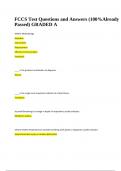
-
FCCS Test Questions and Answers (100%Already Passed) GRADED A.
- Exam (elaborations) • 11 pages • 2024
- Available in package deal
-
- $11.99
- + learn more
FCCS Test Questions and Answers (100%Already Passed) GRADED A. DIRECT Methodology Detection Intervention Reassessment Effective Communication Teamwork ____ is the greatest contribution to diagnosis. History ____ is the single most important indicator of critical illness. Tachypnea Kussmall Breathing (or change in depth of respiration) usually indicates Metabolic acidosis Cheyne-Stokes Respiration (or periodic breathing with apnea or hypopnea usually indicates Severe brainstem inj...
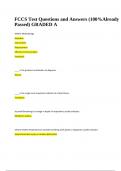
-
FCCS Test Questions and Answers (100%Already Passed) GRADED A.
- Exam (elaborations) • 11 pages • 2024
- Available in package deal
-
- $10.99
- + learn more
FCCS Test Questions and Answers (100%Already Passed) GRADED A. DIRECT Methodology Detection Intervention Reassessment Effective Communication Teamwork ____ is the greatest contribution to diagnosis. History ____ is the single most important indicator of critical illness. Tachypnea Kussmall Breathing (or change in depth of respiration) usually indicates Metabolic acidosis Cheyne-Stokes Respiration (or periodic breathing with apnea or hypopnea usually indicates Severe brainstem injur...
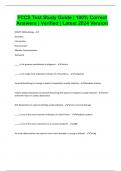
-
FCCS Test Study Guide | 100% Correct Answers | Verified | Latest 2024 Version
- Exam (elaborations) • 7 pages • 2024
- Available in package deal
-
- $7.99
- + learn more
DIRECT Methodology - Detection Intervention Reassessment Effective Communication Teamwork ____ is the greatest contribution to diagnosis. - History ____ is the single most important indicator of critical illness. - Tachypnea Kussmall Breathing (or change in depth of respiration) usually indicates - Metabolic acidosis Cheyne-Stokes Respiration (or periodic breathing with apnea or hypopnea usually indicates - Severe brainstem injury or cardiac dysfunction Biot Respiration (or ataxic br...
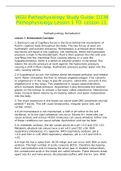
-
WGU Pathophysiology Study Guide: D236 Pathophysiology Lesson 1 TO Lesson 11
- Class notes • 28 pages • 2022
- Available in package deal
-
- $13.50
- 4x sold
- + learn more
WGU Pathophysiology Study Guide: D236 Pathophysiology Lesson 1 TO Lesson 11 WGU Pathophysiology Study Guide: D236 Pathophysiology Lesson 1 TO Lesson 11: Pathophysiology Remediation Lesson 1: Homeostasis Concepts 1. Starling's Law of Capillary forces is the force behind the movements of fluid in capillary beds throughout the body. The two forces at work are hydrostatic and osmotic pressures. Homeostasis is achieved when these two forces are equal in the capillary- cell interfaces. When...
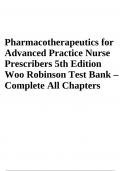
-
Pharmacotherapeutics for Advanced Practice Nurse Prescribers 5th Edition Woo Robinson Test Bank | Complete All Chapters (2023-2024)
- Exam (elaborations) • 353 pages • 2023
-
- $36.49
- 2x sold
- + learn more
The nurse is caring for a 57-year-old woman who is complaining about gaining so much weight after menopause and suggests that thyroid hormone replacement would help her lose weight and speed up her metabolism. What is the nurses best response? A) Inducing a state of hyperthyroidism would result in weight loss. B) People who are not hypothyroid should not take thyroid hormones. C) People who take thyroid hormones without cause will end up damaging their heart. D) The body compensates for th...

-
Study-Guide-psychopharmacology Exam Questions With Solutions
- Exam (elaborations) • 37 pages • 2024
-
- $11.99
- + learn more
Study-Guide-psychopharmacology Exam Questions With Solutions Gray Matter: The cerebellum, cerebrum, brain stem, and butterfly-shaped portion of the central spinal cord are comprised of gray matter which contains neural cell bodies, axon terminals, dendrites, and all nerve synapses. It is the working area of the brain and the focus of psychiatry and neurology. Gray matter is associated with learning. Changes in the gray matter are linked to psychiatric diagnoses including Alzheimer's dise...
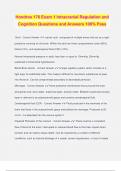
-
Hondros 176 Exam 1 Intracranial Regulation and Cognition Questions and Answers 100% Pass
- Exam (elaborations) • 18 pages • 2024
-
- $12.49
- + learn more
Hondros 176 Exam 1 Intracranial Regulation and Cognition Questions and Answers 100% Pass Skull - Correct Answer ️️ -cranial vault- composed of multiple bones that act as a rigid protective covering for the brain. Within the skull are three compartments: brain (80%), blood (10%), and cerebrospinal fluid (CSF) (10%). Normal intracranial pressure in adult: less than or equal to 15mmHg. 20mmHg sustained is intracranial hypertension. Blood-Brain barrier - Correct Answer ️️ -Unique capi...
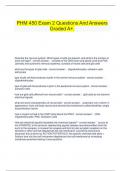
-
PHM 450 Exam 2 Questions And Answers Graded A+.
- Exam (elaborations) • 24 pages • 2024
-
- $12.49
- + learn more
PHM 450 Exam 2 Questions And Answers Graded A+. Describe .the .nervous .system. .What .types .of .cells .are .present, .and .what .is .the .function .of .each .cell .type? .- .correct .answer. . . . .consists .of .the .CNS .(brain .and .spinal .cord) .and .PNS .(somatic .and .autonomic .nervous .systems); .consists .of .neural .cells .and .glia .cells what .are .the .types .of .glial .cells .- .correct .answer. . . . .oligodendrocytes, .schwann .cells, .astrocytes type ....
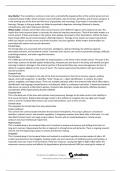
-
Study-Guide-psychopharmacology Exam Questions With Solutions
- Exam (elaborations) • 37 pages • 2024
-
- $11.99
- + learn more
Study-Guide-psychopharmacology Exam Questions With Solutions Gray Matter: The cerebellum, cerebrum, brain stem, and butterfly-shaped portion of the central spinal cord are comprised of gray matter which contains neural cell bodies, axon terminals, dendrites, and all nerve synapses. It is the working area of the brain and the focus of psychiatry and neurology. Gray matter is associated with learning. Changes in the gray matter are linked to psychiatric diagnoses including Alzheimer's dise...
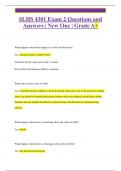
-
SLHS 4301 Exam 2 Questions and Answers | New One | Grade A+
- Exam (elaborations) • 29 pages • 2024
- Available in package deal
-
- $13.79
- + learn more
What happens when blood supply is cut off from the brain? Ans: unconsciousness with in 5-8sec Neuronal activity stops in less than 1 minute Irreversible brain damage within 4-6 minutes What makes up the circle of willis Ans: Veterbral arteries combine to form the basilar artery gives rise to the posterior cerebral artery, the posterior comunicating artery connects that to the internal carotid artery which branches into the middle and anterior cerebral arteries and the anterior communica...

How did he do that? By selling his study resources on Stuvia. Try it yourself! Discover all about earning on Stuvia


